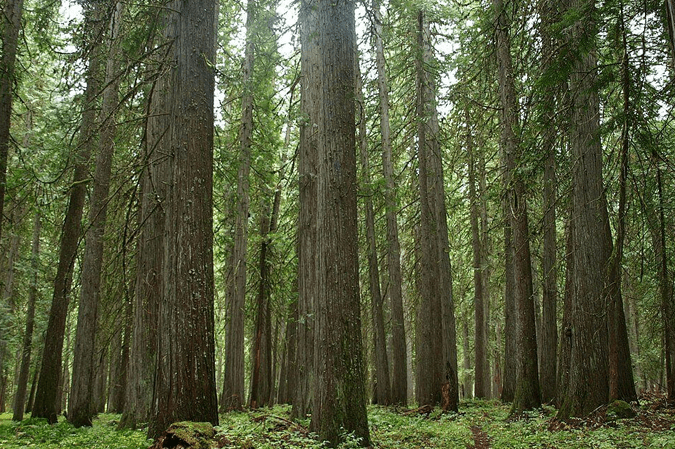Description:
Podocarpus is a genus of coniferous trees and shrubs belonging to the family Podocarpaceae. With around 100 species, Podocarpus is widely distributed across the Southern Hemisphere, including regions of South America, Africa, Asia, and Australasia. These evergreen plants are often recognized for their graceful, needle-like or broad, leathery leaves, and their distinctive fleshy cones that resemble berries. Podocarpus species vary in size, from small shrubs to large trees reaching heights of over 40 meters (130 feet). The name “Podocarpus” is derived from the Greek words “podos” (foot) and “karpos” (fruit), referring to the stalked fruit-like structures that are characteristic of the genus.
Common Features:
- Leaves: Podocarpus leaves can be needle-like, lance-shaped, or broad and leathery, depending on the species. They are typically dark green, glossy, and arranged in a spiral or opposite pattern along the stems. The leaves often have a pointed tip and a thick, waxy cuticle that helps reduce water loss.
- Bark: The bark of Podocarpus trees is generally smooth and gray when young, becoming rough and flaky with age. It often peels away in small, thin strips, revealing a reddish-brown inner bark.
- Cones: Unlike most conifers, Podocarpus produces fleshy cones that resemble berries or drupes. These cones are often brightly colored (red, purple, or blue) and contain one or more seeds. The fleshy part of the cone, called the receptacle, is usually edible and attracts birds and other animals that help disperse the seeds.
- Growth Habit: Podocarpus can be found as shrubs, small trees, or large trees depending on the species and environmental conditions. They typically have a straight trunk with a dense canopy that can be either conical or rounded. The root system is usually extensive, helping the plant anchor in a variety of soil types.
Role in the Ecosystem:
Podocarpus plays a significant role in the ecosystems where it is found:
- Habitat: Podocarpus trees and shrubs provide habitat and food for a wide range of wildlife. The fleshy cones are particularly attractive to birds and mammals, which eat the fruit and disperse the seeds through their droppings, aiding in the propagation of the species.
- Biodiversity: In regions such as New Zealand, South America, and Africa, Podocarpus species are a crucial part of native forests, contributing to the overall biodiversity. These forests support a diverse range of plant and animal life, including many endemic species that rely on Podocarpus for food and shelter.
- Soil and Water Regulation: Podocarpus trees help maintain soil stability, especially in mountainous and forested regions, by reducing erosion. Their deep root systems also aid in water regulation, preventing runoff and maintaining groundwater levels. This is particularly important in tropical and subtropical regions, where they contribute to the health of watersheds.
- Carbon Sequestration: As with other trees, Podocarpus plays a role in carbon sequestration by absorbing carbon dioxide from the atmosphere and storing it in their biomass. This helps mitigate the effects of climate change.
Importance:
- Timber and Wood Products: Podocarpus wood is highly valued for its fine grain, durability, and resistance to decay. It is used in furniture making, construction, boat building, and for decorative purposes. The wood is also used in the production of musical instruments and veneer.
- Ornamental Use: Many species of Podocarpus are popular as ornamental plants in gardens, parks, and landscapes. Their attractive foliage, slow growth, and tolerance to pruning make them ideal for hedges, topiary, and bonsai. Podocarpus macrophyllus, commonly known as the Buddhist Pine or Japanese Yew, is particularly favored for these purposes.
- Cultural and Medicinal Uses: In various cultures, Podocarpus species are used in traditional medicine to treat ailments such as fevers, respiratory issues, and skin conditions. The plant is also considered sacred in some cultures and is used in religious ceremonies.
Interesting Facts:
- Podocarpus species are ancient plants, with fossil records dating back over 200 million years, making them some of the oldest known conifers.
- The Buddhist Pine (Podocarpus macrophyllus) is often used as a Feng Shui plant in Asia, believed to bring good fortune and protection to homes and businesses.
- Unlike many other conifers, Podocarpus produces fleshy, berry-like cones that are not only attractive to wildlife but are also edible for humans in some species.
- Podocarpus is highly adaptable and can grow in a wide range of environmental conditions, from coastal regions to mountainous forests, and is often used in reforestation projects.
Sources:
- Royal Botanic Gardens, Kew: Provides comprehensive botanical information on the Podocarpus genus, including species distribution and ecological roles.
- The Gymnosperm Database: Offers detailed descriptions of Podocarpus species, their habitats, and their uses in forestry and horticulture.
- IUCN Red List: Includes information on the conservation status of various Podocarpus species and the threats they face.
- New Zealand Plant Conservation Network: Provides insights into the role of Podocarpus species in native New Zealand forests and their importance to local biodiversity.
- Image Source: www.thespruce.com



